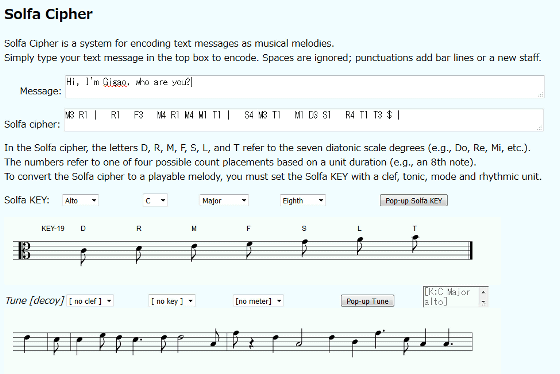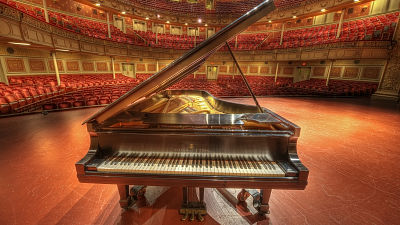Play has been done by large composers to encrypt messages and replace them with "sounds" one by one

ByAfroEngineer
It is known that a kind of "play" that embeds a message in music by a number of composers has been done by replacing the name or feeling that you want to convey in words with "sound". From old Bach to Romantic Brahms, Debussy, and contemporary music owners, play using sounds and words has been inherited from time to time.
With Musical Cryptography, Composers Can Hide Messages in Their Melodies - Atlas Obscura
https://www.atlasobscura.com/articles/musical-cryptography-codes
Encrypting music is a technique that has been used for a long time, and a TV drama "Outlander"And novel"Secret of the White RoseEven the trick is included.
John Wilkins and Philip Tickness, a mathematician and cryptographer from the 17th century to the 18 th century, thought that cryptography using music is the most difficult way to decipher. Even the spies searching for information do not think that messages are hidden in the melody of music, so it is the idea that it is optimal as a method of camouflage. Tickness was 1772,A method of assigning a character to a pitch in a musical score of a tone symbolHas been built. It seems that he was quite confident about the high level of encryption capability, and Tickness told that "as the sounds work on the ear, the music notes the eyes."

As long as the encrypted message is not at least a person with special training, it seems to be very difficult to see its contents. However, according to Professor David Roberg Code of Western Michigan University, there is unnaturalness in the sequence of sounds in which messages are hidden, and some doubt comes down. "As the cryptographic system itself is not musical, the musical score shown in that way will contain musical nonsense, so there is a doubt there," he says, the way the score is written is " Because it is not "musical", there is a view that will disturb its contents.
The following notation shows the cryptogram made by composer Haydn, but the sound of "SO" at the bottom of the score of the note corresponds to "A" of the alphabet. And the musical scale and alphabet are associated with "B" for "#So" on that semitone and "C" for "Bode La", but if you look closely it is "#So" and "♭ La "Is actually the same sound. Therefore, if you give priority to describing a word, the actual score becomes an unintelligible musical score where the pound sign and the flat sign are intertwined, which makes it far from musical ones.

It was a classical music composer who used the method of embedding messages in music for the first time but it incorporates his name and friend's name into the song rather than being used for spying activities It was said that it was used as "play". Mr. Code said "Composers do not know how to name their names in songs, but it is clear that what was used to convey something", the composer says in the song It is believed that he tried to leave some "mark".
A good example is said to be Johannes Brahms, a German composer of the 19th century. Works of 1868 "The string quartet number 2"Brahms made an attempt to prepare ciphers in the song. In the summer of 1858, Brahms who was then 25 years old fell in a strong love with Agarte von Ziebold, a 23-year-old woman who attended a friend's music class. The two had reached an engagement, but Brahms abandoned this engagement in order to choose the path devoted to music.
After that, von Biebold married another man, but Brahms passed the bachelor all his life. However, Brahms who could not abandon the thought of von Zieboldt, by setting the sound type of the violin from the 162th measure to the 168th measure of this song to "AGAHE", Bongs' s first name of Von Giebolt Agathe "has been expressed since ancient times.
Brahms' Sextet No. 2 in G Major - La Jolla Music Society's Summer Fest 2007 - YouTube
According to Tom Service, who hosts the program on the British BBC radio, this motif appears at the moment the suffering of the song is released and is interpreted as expressing Brahms' heart pain . This is also associated with what Brahms wrote in a letter addressed to a friend that he wrote that "This work has finally been released from love of the past by this work" and releases the suffering which has lost Von Zieboldt again For this reason, this song was born, and the interpretation that the character of the name was embedded in it was done.
There are various opinions in this way of thinking, however,A negative viewThere also exists.
There is a composer who did the same attempt before Brahms. Johan Sebastian Bach, also known as a great composer, is said to be one such person, embedding the movement "B - A - C - H" (♭ シ → ラ ー ド → シ →) in the melody of the song. this isBACH themeIt is what is known as his own last workFuga's techniqueIt will appear in the final part of.
Bach - The Art of Fugue, BWV 1080 [complete on Organ] - YouTube
Roberto Schumann, a friend of Brahms and the same Romantic composer, is said to have embedded such messages in the music. Schumann, piano music collection "Carnival"It is said that the German expression" ASCH "of Ash (Aš) from where Else's Nene von Fricken's hometown did not appear in the name of the fruit was mentioned in the name of sound, and it is said that" As- CH (♭ ラ ッ ド シ シ) "" A - Es - CH (ラ - ♭ - MD - シ シ) "is repeatedly known to appear many times.
Schumann Carnaval Op 9 by Rubinstein - YouTube
After that, even after approaching the modern era, attempts by composers to embed letters in music continue,RavelYaDebussy,Poulenc,Messian,ShostakovichThey are said to have similar "play" in the work.
The work of Messiaan "Meditation on the mystery of the holy Trinity" is said to be a representative example. Messian who was also a composer of contemporary music applied different sounds to the letters of all 26 alphabets and philosophersThomas AquinasofTheological TheologyIt is said that it reproduced the French translation version of.
Olivier Messiaen `MEDITATIONS SUR LE MYSTERE DE LA SAINTE TRINITE` - YouTube
◆ If you want to embed words in your own music
If you want to embed messages in music just like your past composers, you can find useful sites on the net.Solfa CipherIs one such site, and if you set the key of the song and the scale etc by typing in the text, it will automatically make a song.
Solfa Cipher
http://www.wmich.edu/mus-theo/solfa-cipher/
Although it seems that the level to be output is about too high to interpret as "song", it seems to be convenient to try making cryptic songs easily.

Related Posts:
in Creation, Posted by darkhorse_log







